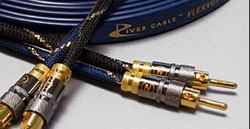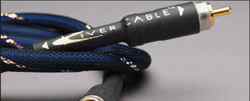 |


TechnoFILE is copyright and a registered trademark © ® of
Pandemonium Productions.
All rights reserved.
E-mail us Here!

Getting Wired with River’s CableBy Jim Bray Cables. They can be one of the bugaboos of the audio/video market. Mainstream audio/video components, when they come with cables at all, generally foist thin and cheap wires on the buyer – wires that most buyers undoubtedly find completely adequate. Until they listen to better wires. A good set of interconnects or speaker cables can indeed enhance the listening experience. Good wire transmits better than bad wire. But with cables running from pennies to hundreds of dollars per foot, and from very thin to almost fire hose thick, at what point do cables become ridiculous? Well, that’s a toughie. We’ve heard cables costing from pennies to hundreds of dollars a foot - and the cables we generally use to connect our reference speakers to our reference amplifier are custom made things that are quite thick and heavy, but which would be priced (if they were retailed) probably in the middle of the pack. Naturally, the bottom line is that it’s your ears (or, in the case of video cables, eyes) that have to judge - as well as the size of your checkbook. And to be fair, a great many people don’t live and breathe this stuff like we do, and spending a lot of money on cables is not something they can justify. To them we say, this article is not for you! Once you’ve decided that you do want to spend some extra after tax income on some good interconnects, you need to wade through the manufacturers, from comparative giants such as Monster to smaller outlets such as the subject of this piece, River Cable. River Cable is a newer entry in the field, at least under that name, and from our experience they make some pretty nice products. River’s parent company has been around for years. Their Digiflex Gold cables are popular in professional applications, places where they not only justify spending extra on quality, but they insist on it (at least to a point). Now, as River Cable, they’re really going after the consumer market, selling directly to customers via their Web site at www.rivercable.com. Their cables cover a wide range of audio and video applications, from straightforward analog “patch cords” to connect a CD player to a stereo preamp or receiver, to digital interconnects, video cables, subwoofer cables, and speaker “wire.” They sent us a couple of pair of their new FLEXYGY 6-conductor speaker cables, a nice product that sounds very nice and is small enough that you don’t need to put ramps on the floor to get over them when walking through the room. The FLEXYGYs are slim and flat, looking almost like an FM antenna. This makes them easy to hide behind a baseboard, under carpet, or wherever. A nice touch, and they’re also colored subtly to be less obtrusive in the room. Not a showcase for your equipment, but that isn’t what you want anyway. And get this: each River Cables cable comes with a birth certificate! Now,
this may seem like a gimmick (and that perception undoubtedly has some truth
to it), but at least they’re giving you something with that gimmick. The
birth certificate includes a printout of that particular cable’s factory
test scores, from a physical check of the cable’s fit and finish, a test
of its DC resistance, capacitance, and something called a Risetime Overshoot
test. Some of our reviewers at least pretended to understand the technical language - unlike me who doesn’t even pretend such. You can take it or leave it, but you have to hand it to these people for their attention to detail and seriousness. River Cable also gives a 30 day home trial guarantee (to make sure you like what you bought) as well as a lifetime warranty. You can get the FLEXYGYs with banana, spade, or pin ends as well. So what makes these thin little buggers good? Well, here’s how the company
describes their construction: Yeah, our eyes glaze over at such stuff, too, and since this is the consumer’s “non-technical” guide to technology, we won’t get into the nuts and bolts any more than that. Let’s talk about how the cables sound, which is the bottom line anyway. We tried them in a variety of configurations and situations. In our main home theater, we hooked them between our big Rotel amplifier and our main Definitive Technology speakers. These speakers feature built in powered subwoofers, so we got to try them with all audio frequencies and with only the upper end. This was our “home theater” setup. We also connected them between a “classic” (read old) NAD amp and some fine Monitor Audio speakers. This was our “home audio” setup. Alas, our reviewers disagreed about the cables. We all liked them but one of our reviewers thought they were a little thin in the low end (though he also admitted that they got better as they broke in). I didn’t find them lacking in low end, however – though on the other hand that other review to whom I refer thinks my hearing is impaired (I think his listening is!). Anyway, I was very pleased with their overall performance. I found the FLEXYGYs cleaner and more transparent than our custom built reference cables, and better sounding than a pair of Monsters I keep around for just such emergencies. It mattered not a whit whether we were using the cables to transmit movie soundtracks or music – including DVD Audio. The FLEXYGYs tended a little to warmness, but not excessively so (and that sure beats being shrill!) and that warmness actually helped with some of the audio sources we tried that tended toward brightness; it was nice to have the rough edges smoothed a bit. Here’s an example: “In the Digital Mood” by the Glenn Miller Orchestra. This is an early digital recording of the old big band classics and it tends to sound a tad sharp. But the FLEXYGYs did a really nice job of taking the roughness from the sound, making it sound more natural and “real”. This might sound a little like an oxymoron, since a cable theoretically shouldn’t add or subtract anything from the sound – it should just pass it along unaltered. But in the real world there’s no cable, indeed no audio component, that doesn’t color the sound in its own subtle (and sometimes not so sublte) way. So if you’re going to color the sound, better to color it nice. And the FLEXYGYs color it nice. I also loved listening to the DVD Audios of Sinatra at the Sands, Chicago II and Led Zeppelin’s “How the West Was Won.” The liveness of the Sinatra concert came through beautifully, Chicago’s horns and electric bass parts sounded very smooth, and Zep’s raw power was almost enough to make one’s ears bleed. The tympani on the second movement of Beethoven’s 9th also came through with spectacular results. In all, very musical – and we also liked the way they transmitted the deep bass of explosions and other movie mayhem. So while the FLEXYGYs may sound a little warm, they don’t sound forced, or colored, or fake. They help create a very nice listening experience, and you can listen all day. We wish we had more of them, enough to wire the rest of the 5.1 channels of our main home theater. Yes, they aren’t cheap. The four meter length FLEXGYs we tried retail for about $260 a pair (different lengths sell for different prices, which makes sense). Not chump change, indeed, but quite affordable in the world of high end cables. Both the Monsters and the custom built cables we used for reference would have sold for substantially more than the FLEXYGYs, which indicates that River Cable seems to be holding up its end of the bargain, especially since I liked the FLEXYGYs better than either of those "competitors." 
Besides the FLEXYGYs, River Cable also sent us an example of their StarFlex Subwoofer cables. This was also a handsome, good performing cable that quickly made itself right at home in our reference home theater. The StarFlex uses oxygen free copper cable and hand soldered Canare connectors, and we have no quibbles with their choice of materials. We ran it between our Rotel processor and the Definitive Technologys’ power subs and between the Rotel and a THX-certified M&K subwoofer and the oomph it transmitted was just fine, thank you. We wish we had another, so we could run them to both of the DefTechs at the same time, but such is life. The bottom line is that the bass we heard (and felt) was full and deep and non-directional, just as it should be. If you don’t know the first thing about cables but are interested in learning, River Cable’s Web site is full of good information on what makes a good cable good, how to choose cables, the differences between different types of cables, and that type of thing. Some of it’s pretty technical, but a lot of it isn’t – and of course they have a special soft spot for their own products. Not that there’s anything wrong with that….
|
|
|
| Support TechnoFile via Paypal |
| TechnoFILE's
E-letter We're pleased to offer our FREE private, subscription-based private E-mail service. It's the "no brainer" way to keep informed. Our Privacy Policy |